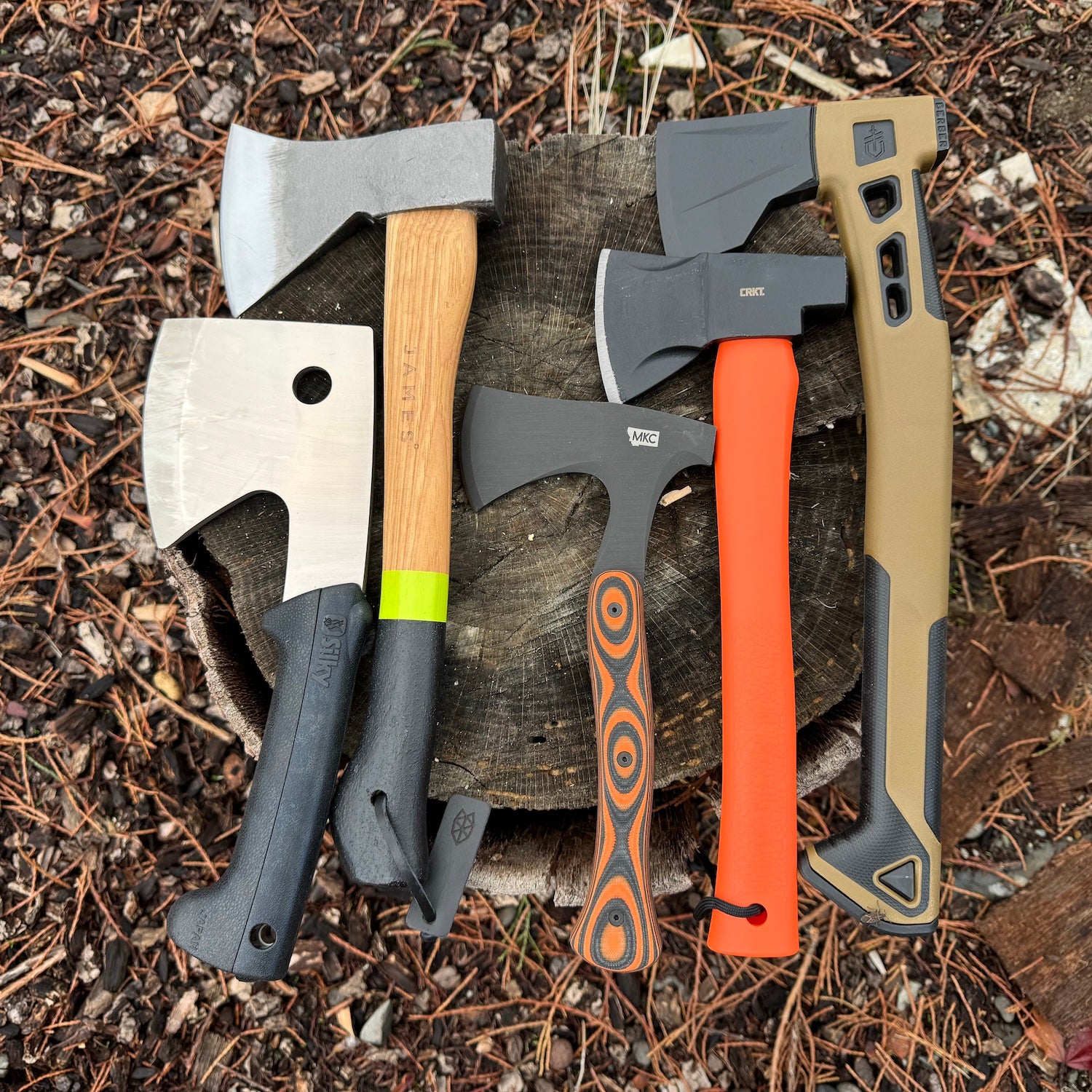November is the time of year when we in the northern hemisphere get that sweet reminder of how shitty it feels to be too cold. If you are one of us who depends on a fire to stay warm through the winter, you know this fact: kindling is king. Whether it’s for your wood stove at 6:00 am when your house is as chilly as the dickens, or when you get off the river with frozen fingers on a fishing trip, the answer remains the same: If you want good kindling fast, you need a good hatchet. To help you find the right one for your needs, I tested some of the best models on the market. Here are my five top picks.
At a Glance
- Best Value:
- Best for Wilderness Survival:��
- Best for Precision Cutting:
- Most Ergonomic:
- Lightest:
- How I Tested
If you buy through our links, we may earn an affiliate commission. This supports our mission to get more people active and outside. Learn more.
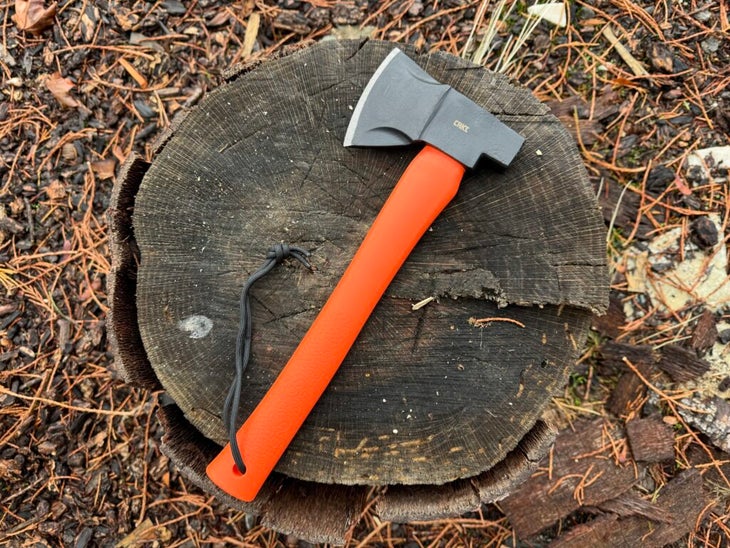
Best Value
CRKT Chogan Hatchet
��
Weight: 1.5 lbs.
Overall Length: 13.2 in.
Pros and Cons:
⊕ Insanely capable
⊕ Extremely affordable
⊗ Not powerful enough for most hardwoods
This one-and-a-half-pound, sub-14-inch hatchet proved small but mighty. The head is made from one solid piece of 1055 carbon steel—known for its durability and edge retention—which was heavy enough in relation to the glass-reinforced nylon handle to provide a hefty swing. This concentration of weight behind the blade allowed it to work its way through softer woods like cedar and fir, but it did find its limitations with the harder woods like madrone and oak. While I could get through the heavier woods, it typically took me at least a dozen strokes, with some feeling dangerously taxing on the nylon handle. It was a heck of a little hammer on the stakes, though, and I found it particularly easy to swing accurately; in fact, it’s about the same size and weight of the hammer I keep in my toolbox back home.
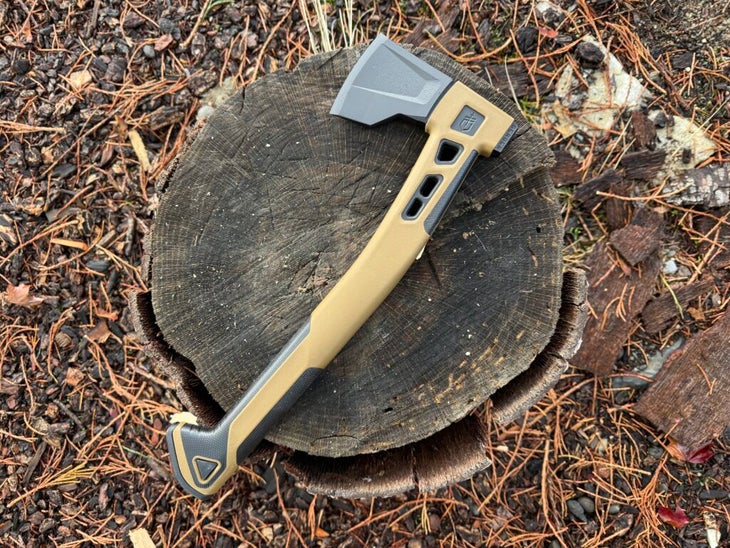
Best for Wilderness Survival
Gerber Bushcraft Hatchet
��
Weight: 2.4 lbs.
Overall Length: 15.3 in.
Pros and Cons:
⊕ Handle doubles as waterproof match storage
⊕ Heavy enough for hardwood
⊗ Rubber gets mangled if you miss a strike
⊗ Blade is small compared to rest of hatchet
My wilderness survival game is relatively tight, but I would by no means call myself a bushcrafter. (In other words, I can reliably make a good fire with a single match, but can’t use a bow drill for shit). Still, I found this hatchet a blast to play with, even with my novice skills. There are five feet of ever-useful paracord in the handle, which contains a hollow, waterproof compartment big enough to store five waterproof matches and half a handful of wood shavings. The Bushcraft’s hefty two-and-a-half-pound weight and more than 15-inch length allowed it to work through oak and madrone quite easily—when it came to hardwoods, it felt more like a small ax than a hatchet. For all the advantages that extra weight gave for the Bushcraft in terms of swing, its heft didn’t do it any favors in the carrying test. This would be my last pick to take on a long hike. It also lacked some blade length compared to the Ono and James Brand options. That made it harder to get through the thickest pieces of wood. The back of the head was a proper hammer that drove even the toughest stakes. The rubber insets around the back of the handle felt good in the hand, but it did get pretty mangled after a few missed strikes on the stakes. While this didn’t hurt the overall performance of the hatchet, it did become a bit unsightly.
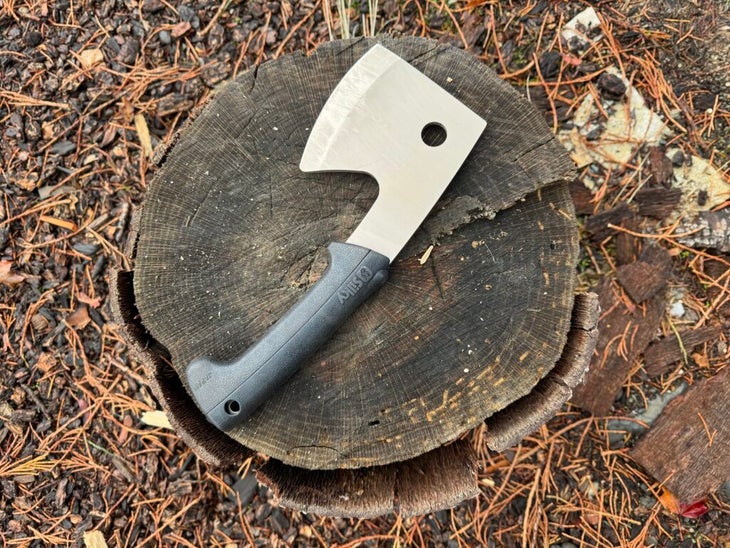
Best for Precision Cutting
Silky Ono Hatchet
��
Weight: 1.8 lbs.
Overall Length: 12 in.
Pros and Cons:
⊕ Crazy-sharp blade
⊕ Very sexy look
⊗ No real ability to hammer
“Ooooooh,” my friend and I moaned audibly as we took this premium Japanese-crafted hatchet out of its hand-wrapped and -written-on packaging. I don’t fault us for our gratuitousness: this hatchet is sexy. It’s a big-ass piece of alloy steel with a perfectly grippy, textured, rubber handle and a four-and-a-half-inch blade. It looks like a meat cleaver you’d want by your side during a zombie apocalypse. The blade is so damned sharp—right on par with the frighteningly sharp Hellgate below—that I could shave pine logs as if they were giant bricks of Parmesan cheese. I really appreciated the superior grip of the handle while I made a 6:00 am fire with frozen fingers, and the swing weight from that large-bladed head let it crush through hardwood in spite of its kinda-short 12-inch length. I couldn’t really hammer tent stakes in with the back of it, which puts it at a disadvantage as a do-it-all camping tool. Still, I was willing to forgive the Ono due to how well it ate through wood to make kindling.
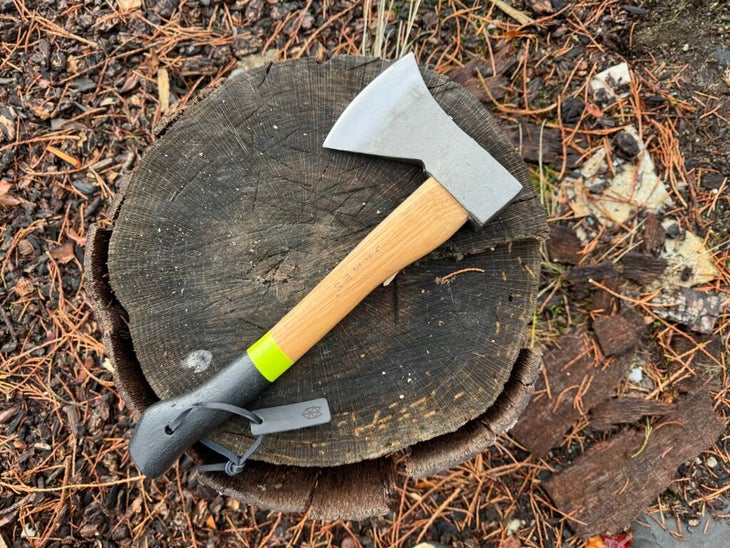
Most Ergonomic
The James Brand TJB Hatchet
Weight: 1.9 lbs.
Overall Length: 14 in.
Pros and Cons:
⊕ Ergonomic wooden handle
⊕ Great swing momentum for extended chopping
⊗ Too big to pack into the backcountry
The James Brand partnered with legendary German ax-making company Adler to craft this beaut. The delightfully contoured, U.S.-sourced hickory handle and big old C60 steel head combine for an incredibly classy-looking hatchet. The blade was plenty sharp enough to make matchsticks out of oak. The TJB also boasted the second-largest striking surface in the test at four inches. The combo of that large, efficient head; the dampening factor of the wood handle; and a nice texture at the base of the grip just felt so damned good, strike after strike. I could make kindling with it all day. In fact, on my camping trip, I got carried away splitting cedar for over an hour straight without feeling much fatigue. It a little on the larger side to bring camping, and is suboptimal to pack in anywhere at its nearly two-pound weigh-in, but this hatchet is definitely the one that will live next to my woodpile at home if The James Brand lets me keep the sample. It feels a little lame to complain about the packaging, but I found myself not knowing what to do with it: When I first received this hatchet, I thought the ornate wooden box it came in was a nice touch, particularly for the price. Unfortunately, I broke the box while transporting the hatchet to my camping trip and had to put it in a landfill pretty quickly into my testing process.
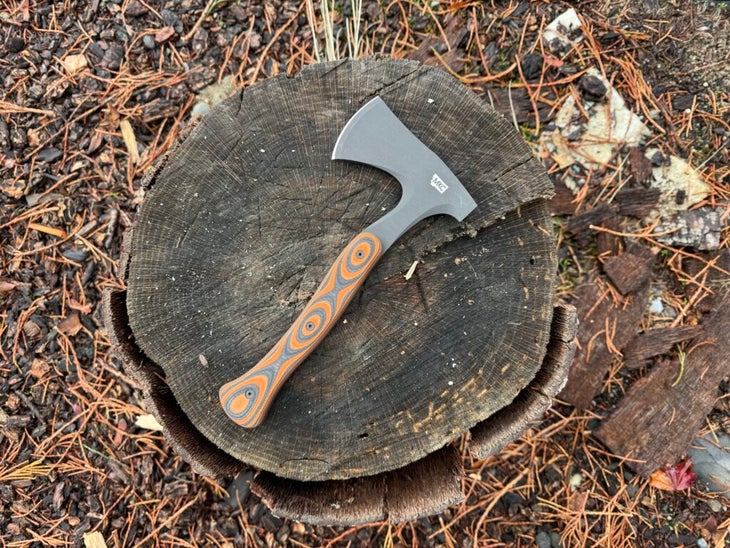
Lightest
Montana Knife Company Hellgate Hatchet
Weight: 0.9 pounds
Overall Length: 10 inches
Pros and Cons:
⊕ Beautiful craftsmanship
⊕ Perfectly balanced swing
⊕ Portable and lightweight
⊗ More than twice the price of most competitors
I know that comparing this hatchet to the others on this list is inherently unfair: It’s like bringing a gun to a proverbial hatchet fight. Or, perhaps more accurately, comparing a cottage-built ultralight thru-hiking pack to a clunky, big box-brand backpacking pack. Here’s the thing, though: I couldn’t leave this truly beautiful tool off this list because it was so remarkably capable. It weighs less than a pound but was still able to cut through softwoods like butter, thanks to its razor-sharp blade and perfectly balanced swing weight. The lack of swing weight meant that hardwoods like madrone put up a hell of a fight, usually taking half-a-dozen hits or more to split, but I wasn’t complaining about the reps thanks to the Hellgate’s aforementioned balance. The lightly textured handle has a slight curve on the back that made it feel like it was made for my palm. This is a very subtle detail that delivered a notable amount of comfort over extended use. I found myself using it consistently for 20- to 30-minute increments without really thinking about the fact that I had a hatchet in my hand. On top of that, the Hellgate was made for hiking. While walking the 60-acre property during my portability test, I barely noticed I was bringing it along. The biggest bummer: The $375 price tag is certainly worthy of sticker shock. Still, I stand behind it: It hit like a heavy weight in a bantamweight package.
How I Tested
I made an absolutely obscene amount of kindling for this test. Over the past three weeks I have offered my kindling-creating services to all the wood-stove users in my friend group (there are four) and invited myself over to chop away on their wood piles for as long as it took to get a feel for each axe. I also took these hatchets on an annual fishing and camping trip with friends. While my buddies fished, I stayed back at camp and played with the hatchets.
I tested each blade on five different kinds of wood (pine, cedar, fir, oak, and Oregon madrone) and created all different sizes of kindling, from curly-gossamer shreds to solid thumb-size chunks. I used the backside of each hatchet to hammer in tent poles at the beginning of the trip. I also carried these hatchets around the 60-acre campsite we stayed on to gauge portability, and I weighed them on a kitchen scale (when I got home of course) to compare each one’s weight to its manufacturer-listed specs. Here are the results.


